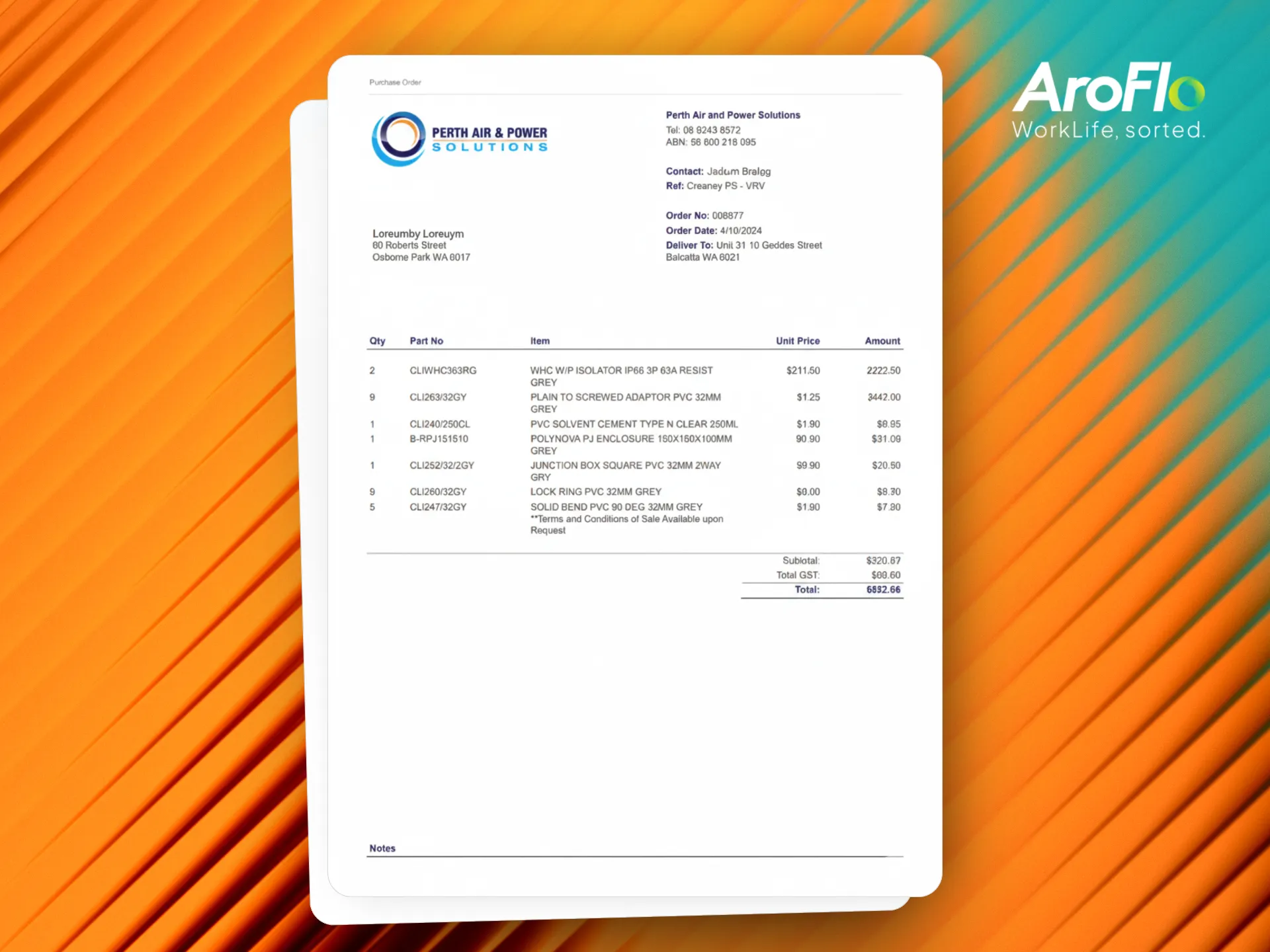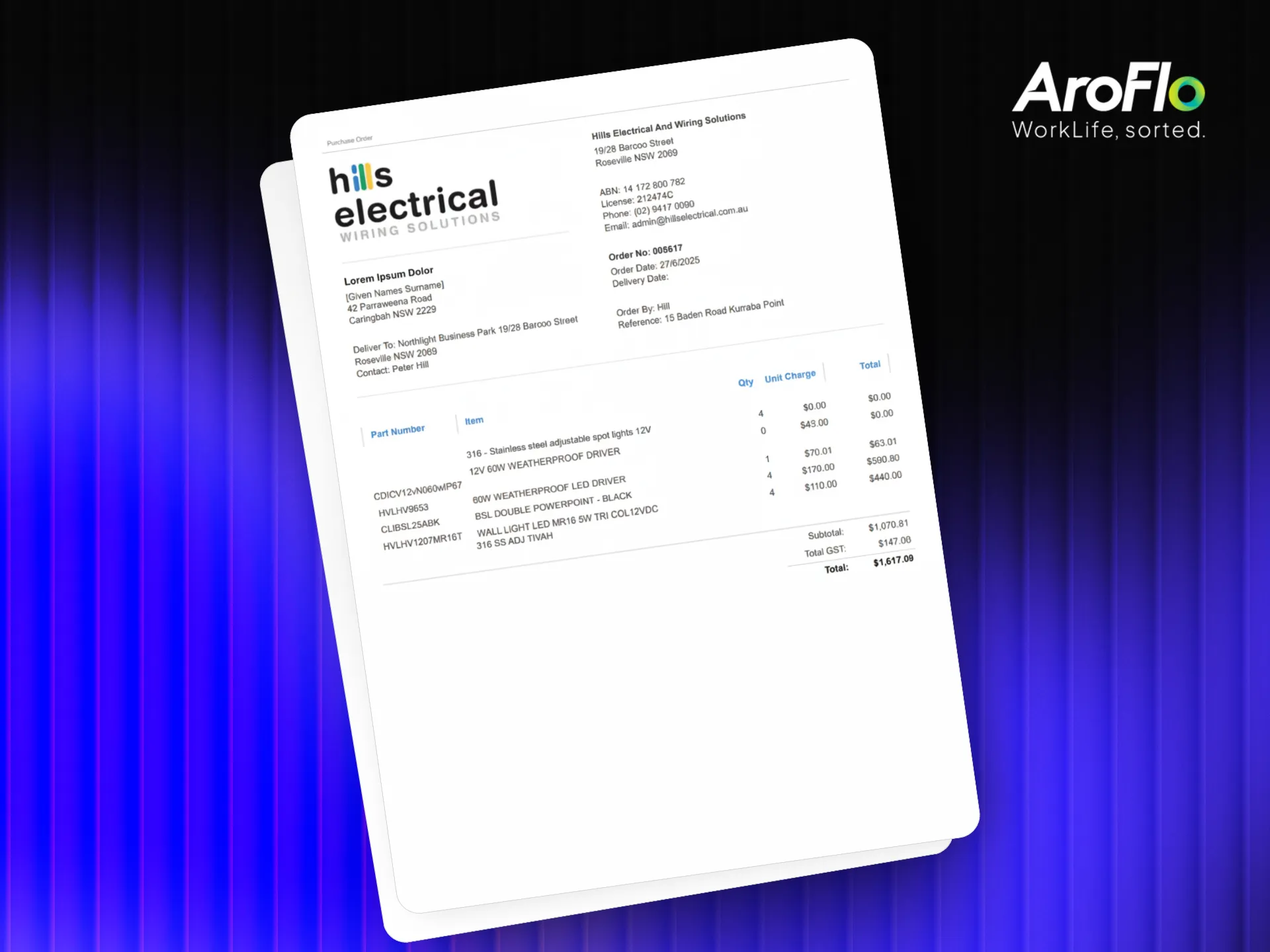“They look messy,” a plumbing contractor told us during a recent consultation, gesturing at the quotes and service reports his team had been sending to clients. “We just don’t have the time to make them look better.”
It’s a problem we hear constantly from field service businesses across Sydney. You’ve invested in Aroflo to streamline your operations, but your customer-facing documents still look like they were thrown together in ten minutes. Because, well, they probably were.
The thing is, those “messy” templates aren’t just an aesthetic problem. They’re costing you opportunities.
Why Your Service Documents Matter More Than You Think
When you’re working with homeowners, real estate companies, or major builders, your quotes and invoices are often the first—and sometimes only—professional impression you make before the job starts. A clunky, inconsistent template doesn’t just look unprofessional. It raises questions about your attention to detail, your systems, and whether you’re the kind of business that can handle larger, more complex projects.
For businesses that service multiple client types, the documentation challenge gets even more complicated. You might need service reports with photos for property managers, separate invoices for accounts teams, and quotes that can flex between showing quantity-only pricing and full GST breakdowns depending on the customer. One template simply doesn’t cut it, but creating multiple variations manually becomes a time sink that pulls focus from actual billable work.
This is where the gap appears between having Aroflo and actually using it effectively. The platform has the power to handle complex, customised documentation, but most businesses get stuck using the basic default templates because they lack either the time or the technical knowledge to build something better.
The Hidden Costs of DIY Templates
The frustration isn’t unique. Many field service teams attempt to create their own template variations, ending up with multiple versions that don’t work well and consume too much time. It’s the classic field service trap: you’re good at plumbing (or electrical work, or HVAC, or facilities maintenance), not graphic design and document formatting.
The default Aroflo template customisation has real limitations. It typically allows for only one page and offers limited flexibility in layout. Multi-page documents and more complex designs need to be created in RTF format before being uploaded to Aroflo—a technical process that most tradies haven’t got the bandwidth to master whilst running their business.
Meanwhile, every hour spent wrestling with template formatting is an hour not spent quoting new jobs, following up on leads, or actually doing the work that generates revenue. It’s also frustrating work that nobody on your team actually wants to do.
What Professional Aroflo Templates Actually Deliver
When we work with clients on custom Aroflo templates, we’re not just making things “prettier”—though they certainly look more polished. We’re building document systems that work the way your business actually operates.
For a client like Hill Electrical, that meant templates with dynamic features that pull attachments directly from Aroflo into their invoices. For Part Ear and Power Solutions, it involved creating quote templates that could accommodate different levels of detail depending on the procurement requirements of different clients.
The difference between standard templates and properly customised ones comes down to three things:
Professional appearance: Documents that look like they came from an established, organised business rather than someone’s home office. Clean layouts, consistent branding, and proper visual hierarchy that makes information easy to find and understand.
Operational efficiency: Templates designed around your actual workflow, not a generic one-size-fits-all approach. If you need to send photos with service reports, capture customer signatures on-site, or include terms and conditions as attachments, the template should handle that automatically.
Client-specific flexibility: The ability to present the same job information differently depending on who’s receiving it. Property managers might need detailed service notes and photos. Accounts teams might just need clean invoicing with proper tax breakdowns. Your templates should adapt to the situation without requiring manual reformatting every time.

The Technical Reality Behind Custom Templates
Here’s what most Aroflo users don’t realise: creating truly effective custom templates isn’t a matter of ticking a few boxes in the settings menu. It requires understanding both the technical capabilities of the platform and the practical requirements of field service documentation.
Multi-page templates need to be built in RTF format before upload. Dynamic fields that pull customer data, job details, and Aroflo attachments need to be properly mapped. Image placement for photos and signatures requires specific formatting to display correctly across different devices and when printed.
Then there’s the variation problem. Many field service businesses discover they need multiple templates for different situations. Some customers require quantity without subtotal. Others need different elements included or omitted, like detailed material breakdowns or simplified GST summaries. Creating and maintaining these variations without a clear system quickly becomes unmanageable.
This is why we approach custom Aroflo templates as a time-based project. We ask clients to send us their current templates (however “messy” they might be), specify how many variations they need, and assess the layout differences required. That gives us a realistic picture of the scope and lets us provide an accurate time estimate rather than promising a quick fix that won’t actually solve the underlying problems.
What the Process Actually Looks Like
When a client sends through their current templates, we examine more than just aesthetics. We look at how information flows through their documents, where the current friction points are, and how the templates need to flex for different client types.
The process typically involves:
Audit and analysis: Understanding what’s working (even in those “messy” templates) and what’s causing problems. Often there are good ideas buried in DIY attempts that just need proper technical implementation.
Template architecture: Designing the structure for each template variation. This isn’t just about where logos and text blocks go—it’s about creating a system that will scale as the business grows and client requirements evolve.
Technical build: Creating the templates in the right format with proper dynamic fields, testing them across different scenarios, and ensuring they pull through the correct Aroflo data.
Refinement: Working through real-world examples to catch edge cases and make adjustments before the templates go live across the business.
The goal isn’t perfection from day one. It’s creating professional, functional templates that immediately improve how your business presents itself whilst being flexible enough to evolve as your needs change.

Beyond the Documents: What Actually Changes
Better documentation does more than make your business look good. It changes how customers perceive your capability to handle larger, more complex work.
When a real estate company sees professional service reports with clear photo documentation and proper formatting, they’re more confident sending you to their premium properties. When a builder receives quotes that clearly break down materials, labour, and GST in a clean, organised format, they’re more likely to see you as a serious contractor capable of handling their compliance requirements.
For businesses working with government contracts or enterprise clients, professional documentation isn’t optional—it’s expected. These organisations have procurement processes that require specific information presented in specific ways. Templates that can deliver that information consistently and professionally remove friction from the sales process and reduce the back-and-forth that delays contract approvals.
Even for residential work, the difference is noticeable. Homeowners might not consciously analyse your invoice formatting, but they register the overall impression of professionalism. That impression influences whether they call you first for future work and whether they recommend you to friends and family.
Getting Started
If you’re nodding along because your own Aroflo templates currently fall somewhere between “functional” and “embarrassing,” you’re not alone. Most field service businesses we talk to are running on default templates or DIY variations that aren’t quite working.
The solution doesn’t have to be complicated. Start by gathering your current templates—however messy—and identify the variations you actually need for different client types and situations. That clarity alone helps you understand whether you need two templates or ten, and what specific functionality each one requires.
From there, it’s about finding someone who understands both the technical side of Aroflo customisation and the practical reality of field service operations. Templates built by designers who’ve never stepped on a worksite tend to miss crucial functional elements. Templates built by techs who don’t understand visual communication often solve technical problems whilst creating new usability issues.
The right approach balances both: professional presentation that also works seamlessly with your actual workflow.
Making the Investment
Custom Aroflo templates are billed on time because every business has different requirements and complexity levels. A plumbing company that needs three template variations will require less work than a facilities management company juggling templates for five different service types across residential, commercial, and industrial clients.
What’s consistent across projects is the return on investment. Time saved on manual formatting. Reduced errors from copy-pasting information between documents. Improved win rates on quotes because they present information clearly and professionally. Better client relationships because your documentation reflects the quality of your actual service delivery.
For field service businesses across Sydney, the question isn’t whether professional templates are worth it. It’s whether they can afford to keep losing opportunities because their documentation doesn’t match their capability.
The messy templates many field service businesses are using represent more than just poor formatting. They represent a gap between what the business can deliver and how professional it appears to potential clients. Closing that gap doesn’t require a complete business transformation—just better systems for the documents that represent your work.
If your service documentation is creating that same gap in your business, it might be time to fix it.
Ready to transform your Aroflo documentation? Spark Interact specialises in custom template development for field service businesses using Aroflo. We understand both the technical platform and the practical requirements of trades and service contractors. Get in touch to discuss your template needs and get a time-based estimate for your specific requirements.




